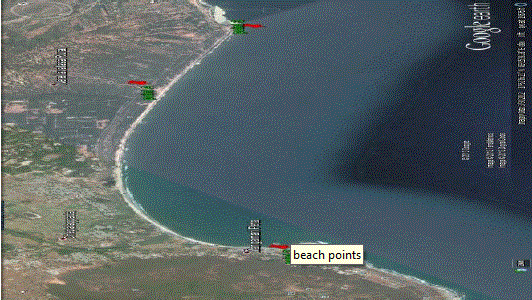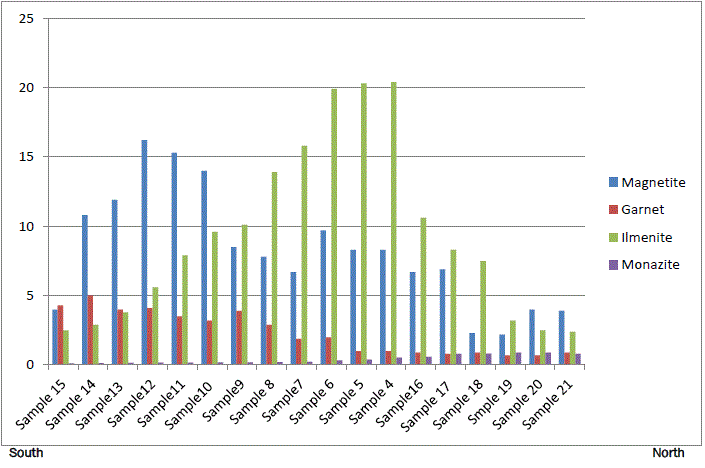B Linda Prabhakar Babu*, J Sandesh, S Saikumar and R Arjun
Department of Geology Osmania University, Hyderabad, Telangana, India
| Corresponding Author: B Linda Prabhakar Babu, Department of Geology Osmania University, Hyderabad, Telangana, India |
| Received: 23/05/2014 Accepted: 26/06/2014 |
Visit for more related articles at Research & Reviews: Journal of Ecology and Environmental Sciences
The coastal cove on Visakhapatnam is a small sheltered bay, dissected in half by an intermittent stream. The cove is unique as the heavy minerals present in it, is a combination of the intermittent stream and coastal processes. Changes in wind, weather, waves, currents and other continental and oceanic processes leave an imprint behind to aid in gaining knowledge on beach changes. Beach samples were collected along a traverse from Chinnamarimanga to Bhimunipatnam, falling between latitude 17°50’ to 17°53’ N and 83°24’to 83°27’ E longitude. Heavy mineral analysis was carried out. The result showed increasing abundance of heavies from Chinnamarimanga to Bhimunipatnam. Abundance of Garnet concentration was found near Chinnamarimanga which decreased along the cove. Ilmenite concentration increased northward. Monazite concentration increased from the stream to Bhimunipatnam. Magnetite shows a decreasing trend from south to north. The ripple mark structures, the well sorted and well-rounded textures and distribution of heavies reveal the sorting of heavy minerals of the cove.
Keywords |
| |
| Magnetite, Ilmenite, Garnet, Monazite |
| |
Introduction |
| |
| Shoreline heavy minerals are affected by changes in sediment supply from continental sources and also influenced by climate, waves and currents [1,2,3,4]. The East Coast of India has a long coastline of 982km long, a part of it belongs to Andhra Pradesh. The coast line of Andhra Pradesh is curvilinear and has two major rivers flowing through it and discharging into the Bay of Bengal. The rivers traverse long distances over varied geological rocks forming two major deltas. |
| |
| The present study area is a protected embayment or cove which has two headlands or ridges abetting into the sea. The two ridges are resistant Khondalite ridges protecting the embayment where the sediments and heavy minerals get sorted due to wave action. The hinter land is the conspicuous red dunes extending 15m landward. A small tributary starting from the red beds flows into the sea in the middle of the embayment. |
| |
Methods |
| |
| The study area falls between 17°50’ to 17°53’ N Latitude and 83°24’to 83°27’ E Longitude. Fifteen beach samples were collected along the coast using hand auger. The samples were washed, dried, and representative samples were separated by coning and quartering method. Heavy minerals were separated using Bromoform using the method after Milner [5]. |
| |
RESULTS AND DISCUSSION |
| |
| The cove has two headlands, one in the north and the other in the south. (Fig.1.) The long shore currents flow from south to north. The wave converges at the headlands due to refraction of waves. The centre of the cove gets the divergent current which creates the sorting of heavy minerals. [6]. The ripple mark structure and the alternating black and brown colored indicate high energy conditions. The wave energy is high enough to winnow away the sand leaving concentration of heavy minerals along the beach. [7] Garnet decreases from south to north. (Table1.) Garnet got entrained because of its lower density and larger size.[7] The size of Ilmenite is very fine. Hence Ilmenite is concentrated at the centre of the cove [7]. Magnetite decreases from south to north. (Fig.2)Slingerland [8] determined that magnetite decreases with increasing bed roughness. The size of Monazite is very fine but has great density hence most difficult to entrain. Hence the concentration of Monazite occurs from the stream towards north. |
| |
Conclusion |
| |
| The processes of mineral sorting have been investigated. The density, size, the bed roughness, and shape of the cove have played a major role in sorting of the heavy minerals. |
| |
Acknowledgement |
| |
| The authors wish to acknowledge their thanks to OU-DST-PURSE, Department of Biochemistry, Osmania University, Hyderabad, for the financial assistance in carrying out this research. |
| |

